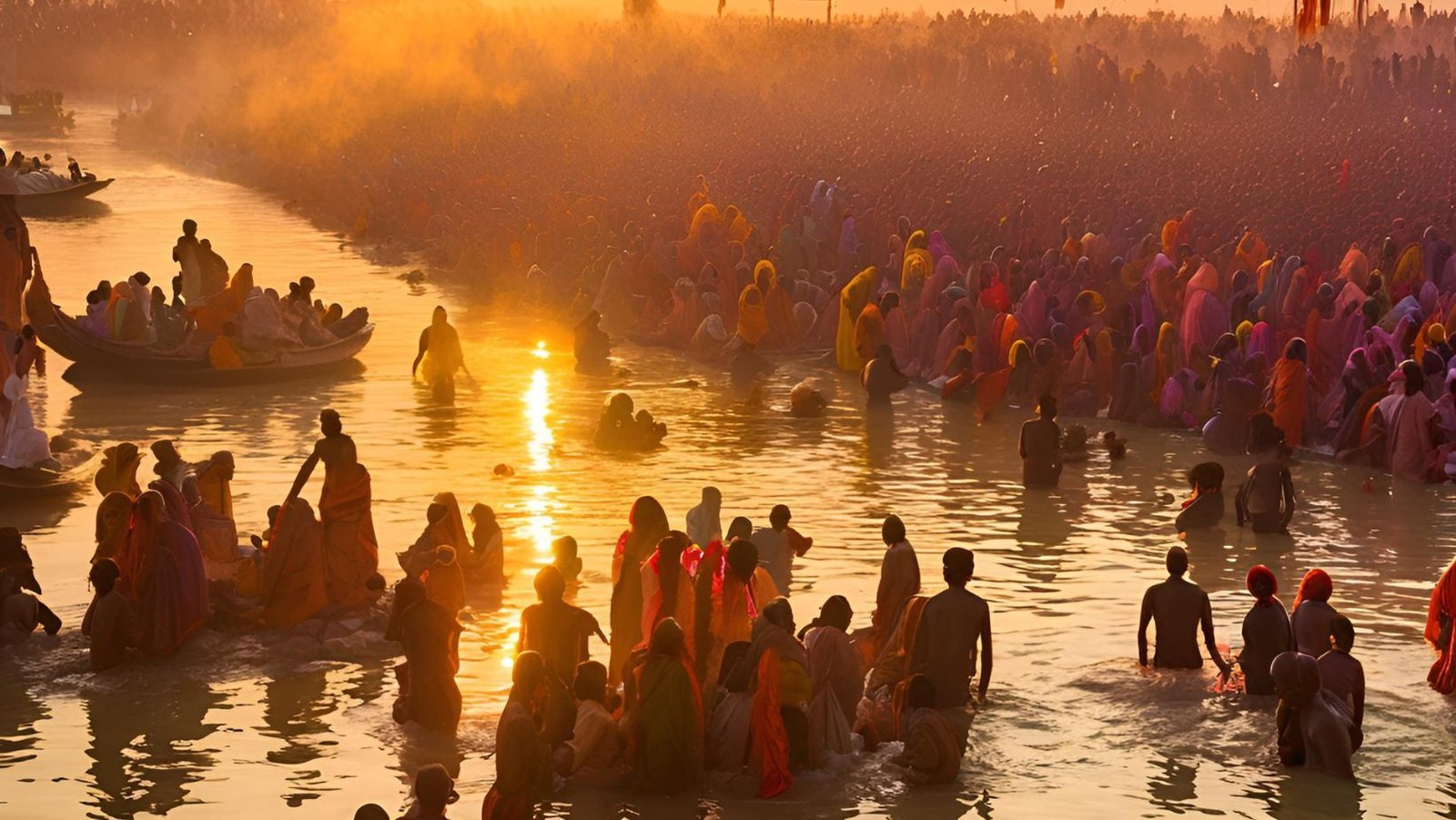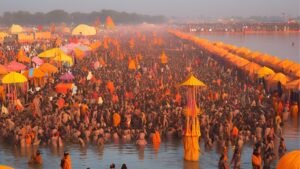MahaKumbh Mela 2025: A Spiritual Journey Like No Other

One of the largest and most electric spiritual events in the world is the MahaKumbh Mela 2025, especially the Maha Kumbh. It is an event, a celebration and ritualistic congregation of hundreds of millions of people once every 12 years at prescribed sites in India. The Maha Kumbh Mela, the largest religious gathering on Earth, takes place once every 144 years and draws pilgrims from all corners of the globe. It is a deep experience with significant cultural, spiritual and historical significance.
MahaKumbh Mela 2025
The 45-day Mahakumbh Mela 2025 considered as the greatest congregation on planet Earth began early Monday on the eve of Paush Purnima. Security arrangements are also in place where around 1.5 crore (15 million) bhakts are scheduled to have a holy dip at Sangam, the confluence of Ganga and Yamuna and the mythical Saraswati.

MahaKumbh Mela 2025
A great multitude of followers congregated at the auspicious site of Triveni Sangam, the sacred merger of the three rivers, in order to perform the most important ritual in the Kumbh Mela.
The most prominent bathing rituals – Shahi Snan: Makar Sankranti will be held on January 14, Mauni Amavasya on January 29 and Basant Panchami on February 3, while the MahaKumbh Mela 2025 itself will end on the 26th of February.
Maha Kumbh Snan Date

| 1 | Paush Purnima | January 13, 2025 |
| 2 | Makar Sankranti (First Shahi Snan) | January 14, 2025 |
| 3 | Mauni Amavasya (Second Shahi Snan) | January 29, 2025 |
| 4 | Basant Panchami (Third Shahi Snan) | February 3, 2025 |
| 5 | Maghi Purnima | February 12, 2025 |
| 6 | Mahashivratri (Final Snan) | February 26, 2025 |
Origins and Mythological Significance
It finds its basis in ancient Hindu mythology – zimmering from the legend of Samudra Manthan or churning of the ocean. As per the myth, the Gods (Devas) and the demons (Asuras) collaborated in churning the ocean to retrieve the nectar of immortality (Amrita). From the ocean, during the churning, emerged a kumbh (pot) which contained the nectar. But in the tussle for the pot, a few drops of the nectar fell at four places in India: Prayagraj (then Allahabad), Haridwar, Ujjain and Nashik
These four places are considered to be sacred Lakshman. Kumbh Mela is held at these spots for which amrut is said to have dropped. Each site takes turns in conducting the Kumbh Mela which occurs only once in three years at the aforementioned locations. The Maha Kumbh Mela however which happens after a period of one hundred and forty four years is considered the most pious and auspicious gathering of people. It is held in Prayag and it is said that taking a bath in the holy river during the Maha Kumbh washes blood born sins and gives the person moksha.
The Spiritual Essence of the Kumbh Mela
Kumbh Mela is not just a carnival rather an important religious occasion, a unique and huge event, millions of citizens of India and some outsiders regard it as an once in a lifetime chance to wipe the slate clean and reach enlightenment. The main activity during the Kumbh is the ritual bath the Kumbh has to take in the sacred rivers in India of which merge three rivers Ganges, Yamuna and the imaginary river of Sarasvati. The river is called Prayagraj Triveni Sangam. This act of bathing at the place where a number of rivers converge is supposed to purify the soul, rehabilitate the body and give immortality
Numbers of Devotees flock to attend Kumbh Mela with full faith as they seek healing, teaching, and pain relief. They perform prayers, offer rituals, and meditate which are only some of the religious practices people engage in. Ascetics and saints and other spiritually enlightened instructors attend these events as well, who then guide the pilgrims through the event whilst sharing wisdom and giving blessings.
This event is a source of reflection on the trustworthy concept of life being temporary, the need for earnestness, and the need to devote time to introspection and purification of one’s self. The Kumbh Mela on one hand, is able to restore a person’s faith and reason, whilst on the other helps them detach from mundane and pettier matters and focus on universal reality instead.
Historical Evolution of the Kumbh Mela
According to tales found in various Hindu scriptures such as Puranas and Mahabharata, Mela Kumbh traces its roots back to ancient times. Kumbh Mela is said to have taken place for the very first time circa 300 before common era. Although, the same seems to hold true for the Kumbh Mela that took place during Harshavardhan’s reigning era in the 7th century CE as well. In order to integrate the diverse peoples of India, Harsha hosted the event.
Historically, the Kumbh Mela has been able to adapt to the influx of pilgrims and seeks to serve as a representation of the broad spirituality present in India as well as portray the vastness of the Hindu religion. While it has always been a celebration for Indians, today it serves as a celebration for everyone across the globe who seeks a form of spiritual emancipation.
Maha Kumbh: The Grandest Gathering
Kumbh Mela has been scheduled to be repeated every three years at varying locations but the Maha Kumbh Mela is one of a kind and is not held too frequently. Every one hundred forty four years in Prayagraj happens to be the last location of the cycle of Maha Kumbh which lasts once every 12 years in each location. While the rest of the Kumbh Melas are significant as well, the Maha Kumbh is the most important one due to its rich spiritual significance, and many people attend it reaching tens of millions.
For the Mela’s intended period, the exact position of various celestial bodies acts as a signal for the astrologers to indicate when the short period is supposed to last, which aids with the alignment of bodiless strengthens possible. Jupiter travels into Aries and during this time, the pairing of the sun and moon moves into Capricorn which makes the spiritual aspects of the pilgrimage significantly stronger.
The Maha Kumbh Mela celebrates itself in the city of Prayagraj, transforming the city into a epicenter of spirituality as thousands of devotees flock on to the city. This event occurs biennially and extends to multiple weeks, with specific days carrying religious significance. People hailing from different parts of the world exhibit an amalgamation of faith, spirituality and an empathetic sense of community together during this event.
Key Rituals and Activities
- The Holy Bath (Snan): At Kumbh Mela, the most anticipated event is the holy clean bath, the Snan, which is considered the most holy act in Hindu faith and cleanses the followers from their wrongdoings. Within the sacred river, designated bathing spaces are arranged for the followers and they are widely located at Prayagraj’s Triveni Sangam. Water is considered one of the most purified items, hence an individual’s physical, mental, and spiritual self gets clean.
- Processions of Sadhus and Saints: Sadhus and other ascetic religious leaders participating in the Kumbh Mela are one of the most eye catching group of individuals during the event, portraying bare apparent on themselves and covered in ash, they take the holy dip in the river, and demonstrate a deep understanding of the world focusing on their only spiritual aspect of life.
- Spiritual Discourses and Teachings: The Kumbh Mela serves as a hub for spiritual samvad wherein sages, philosophers, and volunteer gurus come to enlighten a multitude of start devotees. Such events foster several charitable organizations which build pop-up camps, where they promote their philosophies and host discussions and spiritual events. Followers and spiritual leaders set up these camps to guide and perform meditation along with other prayers.
- Religious Rituals and Pujas: A variety of pujas (rituals) and other religious festivities are orchestrated and performed by devotees over the span of the festival. For example, fire yajnas, including numerous repetitive mantras, and deity offerings. Feeling the devotion alongside the sincerity of the pilgrims amplifies the overwhelming divine energy within the atmosphere.
- Cultural Events and Celebrations: Although the spiritual purposes are the hallmark of the Kumbh Mela, it is mostly a riotous festival. Traditional dance performances and music culture resources are the spirit of the show. Such events and resources depict the civilization and rich culture of India which fosters the feeling of oneness which prevails in the gathering.
Organizational and Logistical Challenges
Arranging an event of such mass is not easy. The flaws involved in handling everything within the Maha Kumbh Mela is immense. Authorities have to take care of the security along with providing lodging and transport for millions of people, while also keeping the healthcare and sanitation in check.
One of the greatest problems is the management of crowds. The Kumbh Mela has previously witnessed millions of individuals congregating at a single location, which is quite a sight. In order to both ensure order and prevent any untoward incidents, the government and several religious bodies join hands. They also make sure that, as always, the pilgrims are kept safe and proper measures to accommodate the number of people that will arrive are put into place.
The Global Impact of the Kumbh Mela
The Kumbh Mela is more than just an Indian event. It has emerged as an international monument of belief, togetherness, and the spirit of humans. People from all walks of life, whether from India or anywhere abroad, flock to witness the grandeur of this selfless act. The Kumbh Mela, additionally looks more global due to the abundance of tourists, scholars, and journalists from various countries and is undeniably a global religious affair.
The Kumbh Mela, besides being a religious affair, is also instrumental in the economic development of the place where it is held. It includes substantial tourism income, boosting the local economy, aiding local establishments, and creating temporary jobs. Selling religious goods, food, and other services during the time of the Mela strengthens the economy for both the pilgrims and residents.
Conclusion
Maha Kumbh Mela is beyond religiously motivated and peeks into the basin of Indian spirituality. It’s a unique event where millions of people come together from all walks of life and strive for a common goal: the goal of attaining enlightenment from this material world, the goal of being forgiven, and the goal of redemption. The importance of intricacy of MahaKumbh Mela 2025 is not only strictly about the religious practices but also the fusion of human beings that exists in a place which is dominated by the essence of humanity, serenity and devotion to the greater good. Maha Kumbh Mela spells out to us the never ending saga of the search for kann sha and sonic Kuiper belt, it tells us the tale of devotion to God and all things beyond. It is massive display of belief and faith which continues to exude wisdom from one generation to the next and which leaves an imprint in humanity’s collective or unconscious.

